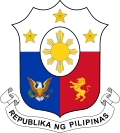Functions
Under the 1987 Philippine Constitution and the Ombudsman Act of 1989, the Office of the Ombudsman independently monitors all three branches of the government for political corruption. The ombudsman "is principally tasked to investigate on its own or upon complaint by any person, in any form or manner, any act or omission of any public officer or employee, including those in government-owned or controlled corporations, which appears to be illegal, unjust, improper or inefficient." [5] After an investigation, the ombudsman files charges at the Sandiganbayan, a special anti-graft court.
The Offices of the Ombudsman includes the ombudsman's own office, along with offices for a team composed of a sheriff, the ombudsman's second in command, and six other deputies who lead their respective divisions or bureaus.
History
The Office of the Ombudsman predates the 1987 Constitution. There have been several offices established under various presidents of the Philippines whose duties are now subsumed under the Office of the Ombudsman. President Elpidio Quirino established the Integrity Board in 1950; President Ramon Magsaysay, the Presidential Complaints and Action Commission in 1957; President Carlos P. Garcia, the Presidential Committee on Administration Performance Efficiency in 1958; President Diosdado Macapagal, the Presidential Anti-Graft Committee in 1962; and finally President Ferdinand Marcos, the Presidential Agency on Reform and Government Operations in 1966. [6]
In 1969, the Office of the Citizens Counselor was created by the Republic Act No. 6028. [6] It was primarily designed to conduct fact-finding investigations and make recommendations to Congress and the President. [6] The office was "not at all implemented." [6] Subsequently, Marcos created the Complaints and Investigation Office in 1970 and the Presidential Administrative Assistance Committee in 1971. [6] None of these were successful nor were independent. [7]
In the martial law-era 1973 Philippine Constitution (Sections 5 and 6, Article XIII), provided for the establishment of a special court called the Sandiganbayan and an office of the ombudsman called the Tanodbayan. [6] On June 11, 1978, during martial law, then President Ferdinand Marcos created by presidential decree the office of the Tanodbayan. [6] [8] The Tanodbayan was not independent but served at the pleasure of the president and could be removed at any time. [8]
After Marcos was overthrown in the 1986 People Power Revolution, President Corazon Aquino issued two executive orders (nos. 243 and 244) in July 1987 that dictated a new Office of the Ombudsman and transformed the Tanodbayan into the Office of the Special Prosecutor under the ombudsman. [5] Following the passage of the 1987 Constitution, the Ombudsman Act of 1989 was passed to define the roles and structure of the Office. [5]
In March 2011, President Benigno Aquino III ordered the dismissal of Emilio Gonzales III as Deputy Ombudsman for Military and Other Law Enforcement Officers for neglecting to properly handle the complaint filed by policeman Rolando Mendoza prior to the Manila hostage crisis in 2010. [9] In September 2012, Gonzales was ordered reinstated by the Supreme Court, which argued among others that he did not commit an offense that could be considered "intentional wrongdoing[...] amounting to betrayal of public trust". [10] [11] By January 2014, the Supreme Court ruled the president's dismissal of a deputy ombudsman to be unconstitutional as it violates the independence of the Office of the Ombudsman provided by the Constitution. [12]
In 2016, Overall Deputy Ombudsman Melchor Arthur Carandang began investigating a plunder complaint filed by Senator Antonio Trillanes regarding the allegedly questionable bank accounts of President Rodrigo Duterte and his family from 2006 to 2016. [13] [14] By July 2018, Carandang was ordered dismissed from office by Executive Secretary Salvador Medialdea for allegedly committing graft, corruption and betrayal of public trust in issuing statements about the Duterte family's bank records. [15] In spite of Carandang's appeal, as well as criticism from observers that Medialdea's order violates the Supreme Court ruling from 2014 regarding the independence of the agency, [16] [17] [18] the dismissal order was enforced on June 17, 2019; [19] [20] Duterte later appointed procurement director Warren Rex Liong of the Department of Budget and Management as ODO in November 2020. [21]
In August 2023, a special panel of investigators at the Ombudsman recommended that Liong be charged with three counts of graft for his alleged involvement in the Pharmally scandal that was uncovered in 2021. [22] [23]
This page is based on this
Wikipedia article Text is available under the
CC BY-SA 4.0 license; additional terms may apply.
Images, videos and audio are available under their respective licenses.









